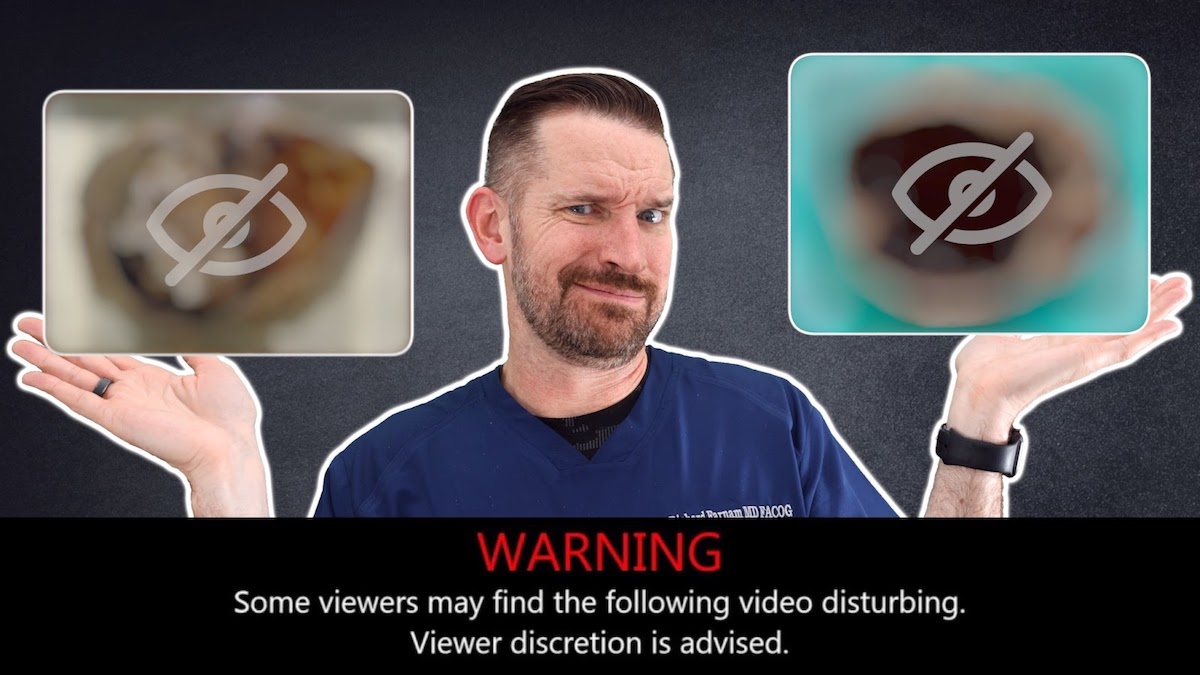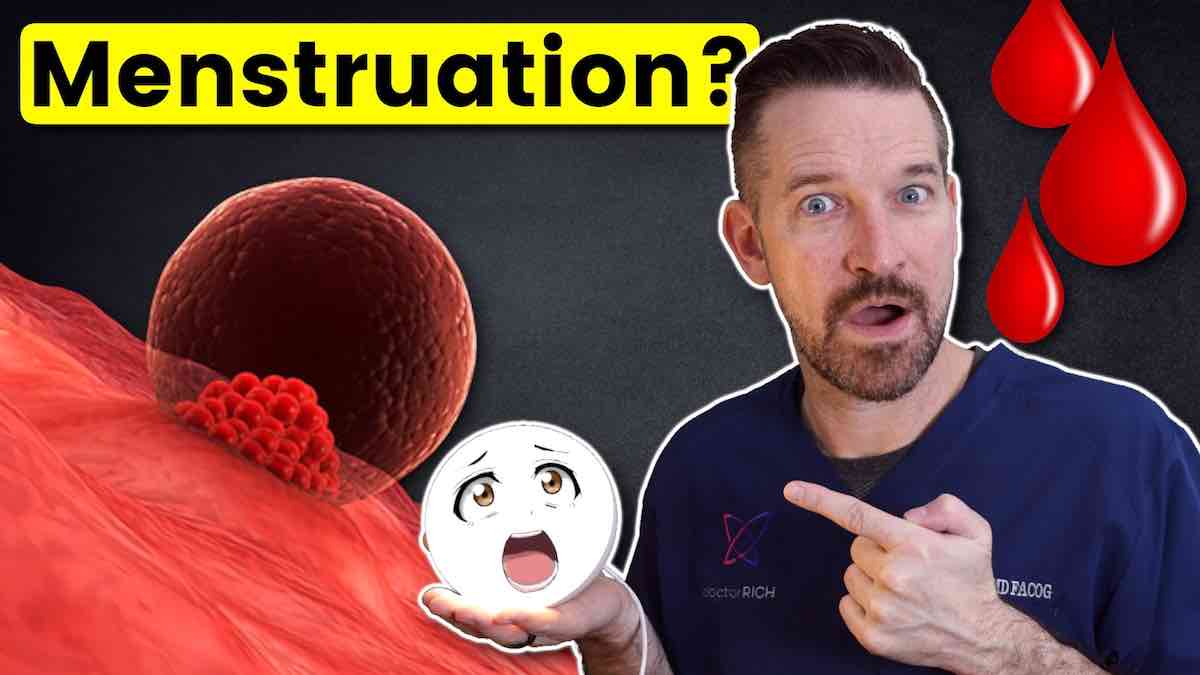Doctor Rich:
Welcome back, I’m Doctor Rich — robotic surgeon, urogynecologist — and my passion is surgical education and patient education. Today, we’re going to do a video on adenomyosis.
Cameraman [offscreen]:
Another endometriosis video?!
Doctor Rich:
No, no… This is a separate condition. It’s not endometriosis — it’s adenomyosis, which many patients have heard of (including viewer Bella). Make sure you stick around to the end to find out what the best treatment for adenomyosis is.
Don’t have time to read this post? Watch the video here instead!
Doctor Rich:
Today, we’re responding to a patient question from Bella. Now Bella’s from the UK, so I’m going to try to channel what (in my mind) this message would sound like:
[in a “British” accent]
| Bella:Can you please do one on abdomylosis? Explain the difference. Women understand awful versus really f****** awful. I have been A & E with this…Lots of criteria I don’t fit. They thought PCOS—not that, can’t perform. What sort of performance? Mostly they just tell you to go to home in the ER, I’m in the UK. So to finally get told that I have this going on when I’ve been trying to deal with it since 2016? |
…or something like that.
So Bella — you’re in luck. Today we’re taking your suggestion, and we’re doing the video. I hope it’s for the right condition — you said “abdomylosis.” I think we’re talking about adenomyosis. What is adenomyosis? Well, it’s similar to endometriosis in symptoms — meaning that women present with heavy periods, painful periods, chronic pelvic pain, and sexual pain.
To understand adenomyosis, we must understand the uterine anatomy. The uterus is made up of three layers. The inner layer is the end endometrium. This is where the lining grows and then sheds every month on your period. The second layer is the myometrium. This is the thick muscular layer that makes up about 90% of the uterus. This is the muscle that will allow for contractions for the delivery of a baby. And the outermost layer is a thin covering called the serosa.
With adenomyosis, the glandular tissue in the endometrium doesn’t respect that boundary — and it actually invades into the myometrium, and you get glandular cells in the muscle that causes swelling. Now, a normal uterus would have the appearance of kind of like an upside down pear. With adenomyosis, the entire uterus swells — and it kind of looks like a big grapefruit.
Now, how is this different from endometriosis? With adenomyosis, you have glands and stroma (these two tissue components) in a layer of the uterus that it’s not supposed to be in. With endometriosis, you get that same tissue (the glands and stroma) in other places in the pelvis and in the body — like on the ovaries and the ligaments. So it is this essential difference that makes endometriosis more treatable with conservative surgery than adenomyosis.
So — what are the treatments before we get into that?
We’ll talk about prevalence. How common is this? It’s estimated between 20 and 35% of women have this condition.
So how do I identify it?
Patients will present with the symptoms that we mentioned, we’ll do a clinical exam, and we’ll find that the uterus is enlarged. We feel that it is “boggy” on clinical exam. And this is confirmed typically by an ultrasound, which will show a pattern of this diffuse glandular invasion into the wall of the uterus. Now — the more definitive diagnosis can be made with an MRI where you can actually see a blurring of the junctional zone (or the space between the endometrium and the myometrium), and we can more clearly see this glandular invasion.
But the absolute diagnosis can only come from surgery after a hysterectomy is done and the pathologist is able to look at the tissue under microscope to confirm that there are in fact glands in the muscle wall.
Well, the primary treatments are similar to endometriosis, and that is:
- anti-inflammatory medicines
- oral contraceptive pills
- and a treatment that is particularly useful for adenomyosis is a progesterone releasing IUD (or intrauterine device)
Now because adenomyosis is a disease of the uterus itself (the muscle wall) — the only definitive therapy is hysterectomy. But there are some more conservative surgical therapies.
The treatments include uterine artery embolization, uterine sparing resection, and radiofrequency ablation. Uterine artery embolization involves a radiologist doing a minimally invasive procedure with a tiny incision. They put a catheter into the artery that supplies blood to the uterus and they occlude (or block) that artery. Then the uterus itself has less blood supply and it shrinks. There are some cases where the glandular invasion is only focal, and this would be what’s called an adenoma. Now, this is similar to a fibroid — and fibroids, (which you can learn about in this video here) are easier to resect because they have what’s called a pseudocapsule. So as the dissection is going along, you’ll be able to clearly identify where the borders of the fibroid are and remove them.
Not so with an adenoma. With an adenoma, there is no pseudocapsule — and essentially there is no beginning or end. And so when we do the removal of an adenoma or a uterine sparing resection, we’re actually just removing part of the muscle wall. This is somewhat of an experimental procedure, and there is a higher risk of uterine rupture — which can lead to complications during labor and delivery.
Another option is radiofrequency ablation. This is a procedure used to decrease the size of fibroids. It’s a minimally invasive procedure where heat is applied through a needle tip that goes into the fibroid and basically melts the fibroid and makes it smaller. So there have been some experimental uses where this is done in adenomyosis, which have shown some benefit. So the treatment of choice for women who are done childbearing is a hysterectomy. This is the most definitive choice, does not involve removing the ovaries (and can be done as an outpatient with a robot technology with a two week recovery).
And you can check out robotic surgery with this video here. To learn more about robotic surgery recovery, check out Michelle’s video here. So in summary, adenomyosis is the glandular tissue in the wrong place inside the uterus. Endometriosis is this glandular tissue in the wrong place, outside of the uterus, which (for endometriosis) lends itself to more conservative surgery where that disease can be directly removed without having to remove the uterus. Not so much with the adenomyosis where the primary treatments are going to be IUD (for women who are interested in future fertility), and hysterectomy for women who are done childbearing.
Thanks for watching! Bella — forgive me for the accent. [again, in a “British” accent] I’m gonna go put a kettle on.




